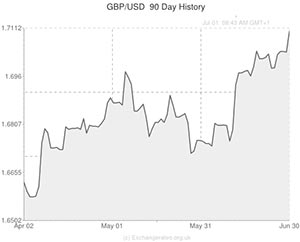
On Monday the GBP to US Dollar (USD) exchange rate was trending in a stronger position in spite of unexpectedly upbeat reports from the US.
After last week’s run of disappointing US figures, the ‘Greenback’ was left languishing against the majority of its most-traded currency counterparts.
The poor US growth, durable goods orders and personal spending figures all helped the GBP to US Dollar exchange rate push above technical resistance of 1.70 and continue trading in that region for much of the week.
The Pound remained fairly defiant in the face of mixed interest-rate messages from the Bank of England and began European trading on Monday little-changed against its US peer.
As currency strategist Adam Cole observed; ‘The Dollar has been heavy for a few weeks now and it’s really a continuation of that trend. It’s being driven by a combination of low yields and low volatility, and the Dollar is just being dragged lower in this environment generally.’
Although a report published this morning detailed a further dip in UK mortgage approvals, the Pound was holding steady against the US Dollar (GBP/USD). Mortgage approvals were shown to have fallen to 61,707 in June from 62,806, taking them to their lowest level for 11 months.
As the overheating UK housing market has been a major cause for concern in recent months (and has had a big impact on the fiscal policy adopted by the BoE) the result was a little surprising but not particularly Pound-moving.
The result also supported last week’s comments issued by the British Banking Association (BBA). The BBA asserted: ‘Our figures indicate that the heat appears to be coming out of the housing market. These are the first mortgage approval figures we have seen since the introduction of the Mortgage Market Review, so it is significant they have fallen for the fourth month in a row. This is being driven by a drop in remortgaging and people borrowing against the value of their homes. There has also been a welcome expansion in business lending this month bolstered by borrowing from the energy sector.’
The GBP to US Dollar exchange rate remained trending in a stronger position following the publication of US Pending Home Sales figures. Home sales were shown to have increased by 6.1% in May, month-on-month, following a positively revised gain of 0.5% in April.
On the year, pending home sales were down by a revised 9.3% in April and 6.9% in May.
After this data was published a separate report showed that the Dallas Fed Manufacturing Activity gauge jumped from 8 to 11.4 in June, surpassing expectations for an increase to 10.
Later today Federal Reserve Bank of San Francisco President John Williams is due to speak. If he offers any insight into the timeline for raising US interest rates it could inspire movement in the US Dollar.
As the week progresses, volatility in the GBP to US Dollar (USD) exchange rate could be caused by the US ISM Manufacturing gauge, UK Markit Construction, Manufacturing and Services PMI and of course Thursday’s US non-farm payrolls report. US markets are closed on Friday for a public holiday.
UPDATED: 06:30 GMT 01 July, 2014
Pound to US Dollar Exchange Rate Pushing Higher
The GBP to USD exchange rate jumped above the 1.71 level yesterday even as US Pending Home Sales data showed an unexpectedly strong increase in sales.
The US Dollar also slid to a one-month low against the Euro yesterday after the odds of the Federal Reserve increasing interest rates in the near future fell further in response to the news that an index of US business activity dipped by more than expected.
UPDATED: 15:10 GMT 01 July, 2014
GBP to USD close to 6 Year High
The Pound was trading close to a six-year high against the US Dollar after the UK currency found support from the release of stronger than expected manufacturing PMI data. The data once again increased speculation that the Bank of England will raise interest rates before the end of the year and increased optimism over the UK economy.
Markit’s UK manufacturing PMI climbed to a seven-month high of 57.5 last month, better than the previous figure of 57.0 and beat economist forecasts for a decline of 56.8. The PMI has now shown expansion for 16 consecutive months and has seen expectations for the second quarter climb to its best level since 2011.
The US Dollar continued to be under pressure by expectations that the Federal Reserve will leave interest rates close to 0%. It was weakened further after the latest ISM PMI data came in below forecasts. Construction spending also dropped.
As the day continues the GBP to US Dollar (USD) exchange rate could fluctuate in response to the UK’s Markit Manufacturing PMI and the US ISM Manufacturing Report.
US Dollar (USD) Exchange Rates
[table width=”100%” colwidth=”50|50|50|50|50″ colalign=”left|left|left|left|left”]
Currency, ,Currency,Rate ,
US Dollar, ,Pound Sterling,0.5854,
,Pound Sterling,0.5854,
US Dollar, ,Canadian Dollar,1.0672,
,Canadian Dollar,1.0672, 
US Dollar, ,Euro,0.7313,
,Euro,0.7313,
US Dollar, ,Australian Dollar,1.0644,
,Australian Dollar,1.0644,
US Dollar, ,New Zealand Dollar,1.1423,
,New Zealand Dollar,1.1423,
Canadian Dollar, ,US Dollar ,0.9380,
,US Dollar ,0.9380,
Pound Sterling, ,US Dollar,1.7082,
,US Dollar,1.7082,
Euro, ,US Dollar,1.3676,
,US Dollar,1.3676,
Australian Dollar, ,US Dollar,0.9410,
,US Dollar,0.9410,
New Zealand Dollar, ,US Dollar,0.8752,
,US Dollar,0.8752,
[/table]

Comments are closed.